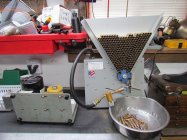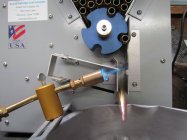2. I anneal out in my shop and the in winter it can be in low 40’s and when those 1 pound propane bottles get that cold I learned that the propane compresses and your flame pressure decreases and becomes very inconsistent. I started keeping a bottle in the house.
3. Get a 5lb bottle and a hose. Seems so much easier than messing with the 1lb.
4. Get a swirl flame tip. I did 50 pieces of 7prc brass tonight and it worked beautifully.
For years, I ran my set up off a propane grill tank. Cheaper and more
consistent. I plumbed the garage for natural gas, then came up with
opposing pencil tips to run off that supply, Even more consistent.
I'll turn out the lights and adjust the motor's drive speed to a point
that the necks are a dull red glow color then run em'. Generally it takes
6 seconds in the flame for Peterson. brass. I ran some thicker .308 LC
brass for a friend, and had to bump it up to 8 seconds.
Last edited:













